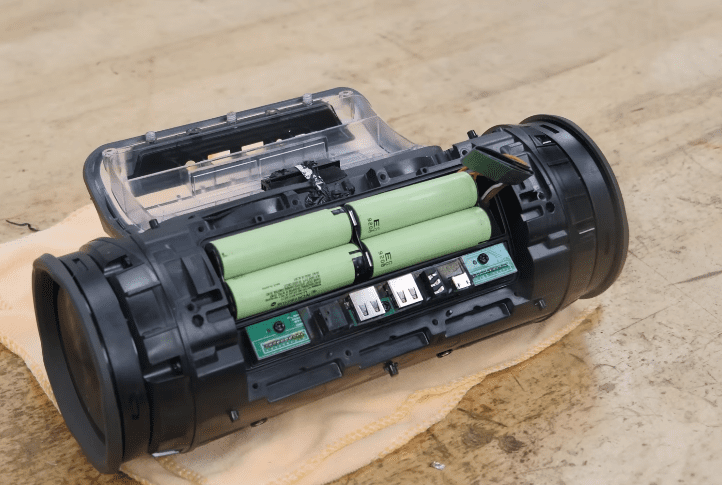Table of Contents
Have you ever had your favorite tunes cut short by a speaker that just couldn’t keep up? We’ve all been there, and it’s why the battery life of portable speakers is more than just a spec—it’s the heartbeat of your music experience. Whether you’re planning an all-night campfire jam, setting up a cozy workspace, or just unwinding at home, a speaker’s endurance is key. Join me as we dive into what really keeps your speakers playing longer. From understanding the tech behind the batteries to simple tips on usage and charging, let’s ensure your music never stops unexpectedly again.
1. Understanding Battery Technology

In the realm of portable speakers, battery technology is a fundamental aspect that defines their efficiency and usability. Predominantly, Lithium-ion (Li-ion) and Lithium-polymer (Li-po) batteries are at the forefront, powering these devices. The choice between these two types often boils down to their distinct characteristics. Li-ion batteries are known for their high energy density and longevity, making them ideal for longer playtimes. They are typically found in a wide range of consumer electronics due to their reliability and established manufacturing processes. On the other hand, Li-po batteries, while slightly more expensive, offer a more flexible and lightweight design, an attribute crucial for portable devices. They can be manufactured in various shapes and sizes, accommodating the innovative designs of modern speakers. The evolution and continuous improvement of these battery types have been instrumental in enhancing speaker performance. This has led to longer usage times and increased durability, thus elevating the overall user experience in portable audio devices.
2. Capacity vs. Efficiency
Delves into the intricate balance between a speaker’s battery capacity and its power efficiency. The capacity, quantified in milliampere-hours (mAh), serves as a fundamental metric, indicating the potential operational duration of a speaker. It’s a straightforward measure – the higher the mAh, the longer the speaker can theoretically run. However, this is only part of the story. The true efficacy of a speaker’s battery lies in its power efficiency, a more complex and crucial aspect. Power efficiency is influenced by several factors including the speaker’s design, the sophistication of its internal circuitry, and the implementation of intelligent power management systems. These elements work collectively to optimize battery usage, ensuring that the available capacity is used in the most effective manner. Thus, while capacity provides the raw potential for longevity, it’s the efficiency of power usage that ultimately determines how effectively that potential is realized in day-to-day usage of the speaker.
3. The Role of Speaker Size and Power

The relationship between the size and power of a speaker is a critical factor in determining its battery life. Larger speakers, often packed with more powerful components, are designed to deliver a richer and more immersive audio experience. However, this comes at a cost – they typically require more energy to operate, which can lead to quicker battery depletion. This is a crucial consideration for consumers who prioritize portability and longevity in their speakers.
To illustrate this point, Shaun Conroy’s comparative analysis of the JBL PartyBox 310 and 110 models offers enlightening perspectives. His review, accessible here, explores how these two models, differing in size and power, manage to balance sound quality with battery efficiency. Through his examination, readers can gain a deeper understanding of how the physical dimensions and power output of speakers influence their overall battery performance, providing valuable insights for those looking to make an informed purchase decision.
4. Usage Patterns and Their Impact
The impact of usage patterns on a speaker’s battery life is substantial and often underestimated. How and how often we use our portable speakers can dramatically alter their battery longevity. One of the primary factors is the volume level. Consistently playing music at high volumes demands more power, thereby draining the battery quicker. It’s a balancing act between enjoying rich, full sound and conserving battery life.
Connectivity choices also play a significant role. Options like Bluetooth and Wi-Fi, while providing convenience and wireless freedom, can consume more battery power compared to wired connections. Each connection type has its own energy requirements, and understanding these can aid in making more battery-efficient choices.
Moreover, the frequency of use directly impacts battery health over time. Regular, intense usage can lead to quicker battery degradation. To extend the lifespan of your speaker’s battery, it’s advisable to manage these usage habits. Moderating volume levels, opting for energy-efficient connectivity options when possible, and giving your speaker some rest can collectively contribute to a longer-lasting battery experience. This mindful approach not only enhances your immediate listening experience but also ensures your speaker remains a long-lasting companion.
5. Charging Technologies and Practices
The realm of portable speakers is witnessing a revolution in charging technologies and practices. Innovations like fast charging have dramatically reduced the time needed to juice up speakers, ensuring they’re ready for use more quickly. This is especially beneficial for those constantly on the move, allowing for minimal downtime. Solar charging, another emerging trend, taps into renewable energy, offering an eco-friendly way to power devices while outdoors. It’s particularly useful for camping or beach trips, where traditional power sources are scarce.
However, with these advancements come responsibilities. To maximize the lifespan and efficiency of speaker batteries, adhering to best practices is crucial. This includes avoiding overcharging, which can degrade battery health over time, and maintaining moderate temperature conditions, as extreme temperatures can negatively impact battery performance. Also, using the manufacturer-provided charger is recommended, as it ensures the right amount of power is delivered to the battery. By following these guidelines, users can ensure their portable speakers remain reliable companions for their audio adventures.
Conclusion
For those seeking durable speakers, a comprehensive understanding of battery technology is vital. This includes balancing capacity with efficiency, acknowledging how a speaker’s size and power affect battery life, being mindful of usage patterns, and embracing efficient charging methods. These factors collectively determine a speaker’s longevity, making them essential considerations for consumers aiming to make an informed purchase in the portable speaker market.
